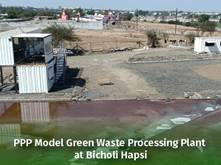Public infrastructure is the backbone of economic development, enhancing connectivity, trade, and overall quality of life. India, the world's fifth-largest economy, has made remarkable progress in infrastructure development over the past decade.
The total infrastructure investment in India has significantly increased, with public and private sector contributions shaping the growth trajectory. India's total infrastructure spending has grown exponentially, with budget allocations rising to ₹10 lakh crore in 2023-24.
PM Gati Shakti
The PM Gati Shakti National Master Plan (NMP), launched in 2021, is designed to bring together various Ministries, including Railways and Roadways, to ensure integrated planning and coordinated execution of infrastructure projects. The initiative aims to provide seamless and efficient connectivity for the movement of people, goods, and services across various modes of transport, thereby enhancing last-mile connectivity and reducing travel time. This project has onboarded 44 Central Ministries and 36 States/UTs and a total of 1,614 data layers have also been integrated, by October 2024. A milestone of assessing 208 big-ticket infrastructure projects worth Rs. 15.39 lakh crores, of various Ministries adhering to PM Gati Shakti principles has been achieved.
India’s World Bank Logistics Performance Index (LPI) ranking improved by 6 places from 44 in 2018 to 38 out of 139 countries in 2023. To complement PM GatiShakti, National Logistics Policy was launched in September 2022. 26 states have notified their State-level logistics policy, so far.
Highways and Roads
India has the second largest road network in the world and its National Highways span a total length of 1,46,145 km, forming the primary arterial network of the country. The Government of India has undertaken several initiatives to enhance and strengthen the National Highways network through flagship programmes such as the Bharatmala Pariyojana which includes the subsumed National Highway Development Project (NHDP), the Special Accelerated Road Development Programme for the North-East Region (SARDP-NE), and many more ongoing projects.
- India's National Highway (NH) network expanded from 65,569 km in 2004 to 91,287 km in 2014 and 1,46,145 km in 2024.
- NH stretches with four or more lanes grew 2.6 times from 18,371 km in 2014 to 48,422 km in 2024.
- Operational High-Speed Corridors increased from 93 km in 2014 to 2,138 km in 2024.
- NH construction pace rose 2.8 times from 12.1 km/day in 2014-15 to 33.8 km/day in 2023-24.
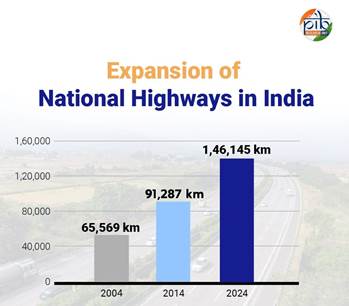
- Capital expenditure (including private investment) surged 5.7 times from ₹53,000 crore in 2013-14 to ₹3.01 lakh crore in 2023-24 (highest ever).
Bharatmala Pariyojana
Launched in 2017, the Bharatmala Pariyojana envisages development of about 26,000 km length of Economic Corridors, which along with Golden Quadrilateral (GQ) and North-South and East-West (NS-EW) Corridors are expected to carry majority of the freight traffic on roads. It also envisages development of ring roads / bypasses and elevated corridors to decongest the traffic passing through cities and enhance logistic efficiency. A total of 18,926 km of roads have been completed under project by November 2024.
Further network of 35 Multimodal Logistics Parks is planned to be developed as part of Bharatmala Pariyojana, with a total investment of about Rs. 46,000 crore, which once operational, shall be able to handle around 700 million metric tonnes of cargo.
Pradhan Mantri Grameen Sadak Yojana
The Pradhan Mantri Gram Sadak Yojana (PMGSY), was launched by the Government of India, in 2000, to provide connectivity to unconnected habitations as part of a poverty reduction strategy.
In 2006-2007, 1,07,370 km of roads were completed under the PMGSY, with a total expenditure of ₹10,769 crore. In 2014-15, 4,19,358 km of roads were completed with a total expenditure of ₹130,149 crore and in 2024-25, 7,71,950 km of roads were completed with a total expenditure of ₹ 331,584 crore.
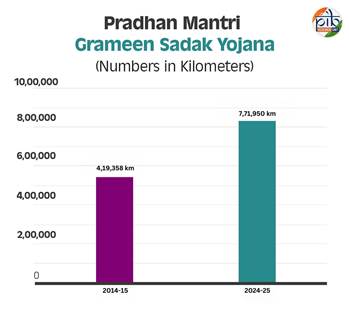
Civil Aviation
India's aviation sector is experiencing a meteoric rise, fueled by soaring demand and the government's unwavering commitment to its growth through supportive policies. This dynamic shift has propelled India to the forefront of the global aviation ecosystem, becoming the third-largest domestic aviation market in the world.
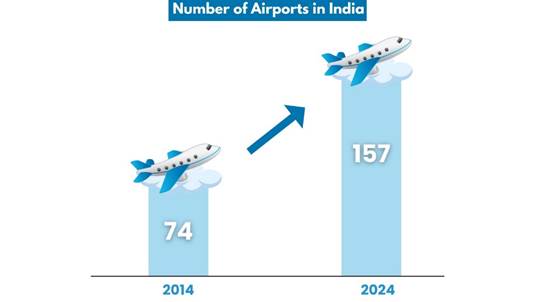
- The number of operational airports in India in 2014 were 74. By September 2024, the number had increased to 157.
- Over 15% of India’s pilots are women, significantly higher than the global average of 5%.
- Marking a new record, domestic air passenger traffic crossed 5 lakhs for the first time in a single day on November 17, 2024.
- The number of Flying training organisations (FTOs) in June 2016 was 29. This number increased to 38 with 57 bases by December 2024.
- In terms of aircrafts, the numbers have increased from around 400 in 2014 to 723 in 2023, despite the impact of Covid-19.
Regional Connectivity Scheme (RCS) - UDAN (Ude Desh ka Aam Nagrik)
By reviving existing airstrips and airports, UDAN, launched in 2016, aims to bring essential air travel access to previously isolated communities and boost regional economic development. With a ten-year operational plan, UDAN intends to ensure equitable access to air travel for all Indians. As of 31 Dec 2024-
- 147.53 lakh passengers have availed of the benefits of the scheme.
- More than 2.93 lakh flights have operated under the UDAN scheme so far.
- 619 RCS routes have so far commenced operations connecting 88 airports including 13 heliports & 2 water aerodromes.
Shipping and Ports
The Maritime Sector in India comprises of Ports, Shipping, Shipbuilding, Ship repair and Inland Water Transport Systems. In India, there are total 12 government owned major ports and approximately 217 minor and intermediate ports. Indian Shipping Industry has over the years played a crucial role in the maritime sector of India’s economy. Approximately 95% of the country’s trade by volume and 70% by value is moved through Maritime Transport.
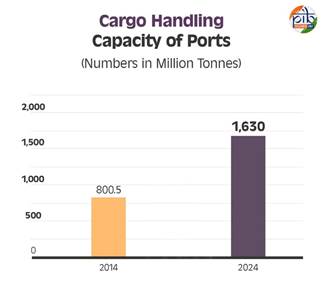
- Cargo handling capacity has increased from 800.5 million tonnes per annum in 2014 to 1,630 million tonnes per annum in 2024. Vis-à-vis 2014, this is an 87% improvement.
- India has reached 22nd rank in International Shipment category as against 44th rank in 2014.
- Turn Around Time (TRT) of major Ports has reduced from around 94 hours in FY-2013-14 to only around 48.06 hours in FY 2023-24.
- The average ship berth-day output vis-a-vis FY 2014-15 have improved by 52%.
- Tourist footfall in 2022-23 for ocean cruise has risen to 3.08 Lakhs and for light house has risen to 12.3 lakhs compared to the year 2014-15.
- The number of ships/vessels increased from 1,250 in 2014-15 to 1,526 in 2023-24, culminating in a 22% increase.
- Number of employed sea-farers are:
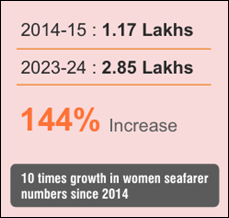
Railways
Indian Railways achieved a historic milestone, transporting over 3 crore passengers in a single day on November 4, 2024. On this day Indian Railways carried a record number of 120.72 lakh non-suburban passengers. This included 19.43 lakh reserved passengers and 101.29 lakh unreserved non-suburban passengers. Similarly, the suburban traffic reached a record 180 lakh passengers, making it the highest single-day passenger figure of the year.
- The manufacturing of Linke-Hofmann-Busch (LHB) coaches has increased from 2,209 coaches in year 2006-2014 to 31,956 coaches in year 2014-2023.
- The provision of Bio-toilets in coaches has been increased from 3,647 coaches in year 2006-2014 to 80,478 coaches in year 2014-2023.
- The Production units of Indian Railways are producing only LHB coaches from April-2018 onwards and trains operated with ICF coaches are being converted so as to run with LHB coaches.
- In 2005-06, 33,540 km and in 2014-15, 41,038 km of running tracks were electrified.
- During 2004-14, 14,985 RKM of rail track work was done whereas during 2014-23, 25,871 RKM of track laying work has been done. In the year 2022-23, per day 14 km track was laid.
- Rail connectivity to four states of Meghalaya, Arunachal Pradesh, Manipur & Mizoram provided after 2014 (Meghalaya in November 2014, Arunachal Pradesh in February 2015, Manipur (Jiribam) in May 2016 & Mizoram (Bhairabi) in March 2016).
- Before 2014, the number of stations equipped with CCTV surveillance facilities was 123 whereas during 2014-23, CCTVs were installed across 743 railway stations. By December 2024, CCTV coverage was increased to a total of 1051 stations.
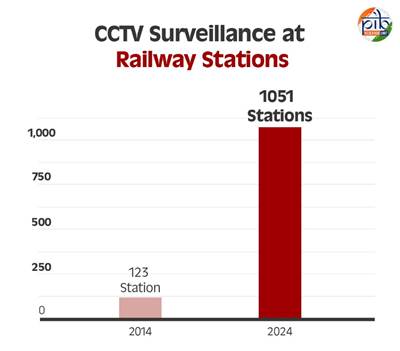
Urban Affairs and Housing
- Under the Smart Cities Mission (SCM), total projects are 8,076, amounting to ₹1,64,706 crore, of which 7,401 projects amounting to ₹1,54,351 crore have been completed, as per the data provided by 100 Smart Cities.
- Under Swachh Bharat Mission – Urban 2.0, there has been a 97% increase in the urban waste collection from 2014-15 to 2024-25.
- The waste processing percentage has increased from 18% in 2014-15 to 78% in 2024-25.
- During 2004-14, 13.46 lakh houses were approved under schemes like JnNURM & RRY. This increased substantially (9 times) in 2015-2024, when 118.64 lakh houses were approved under PMAY-U.
- During 2004-14, 8.04 lakh houses were built and marking a 11x increase, during 2015-24, 88.32 lakh houses were completed.
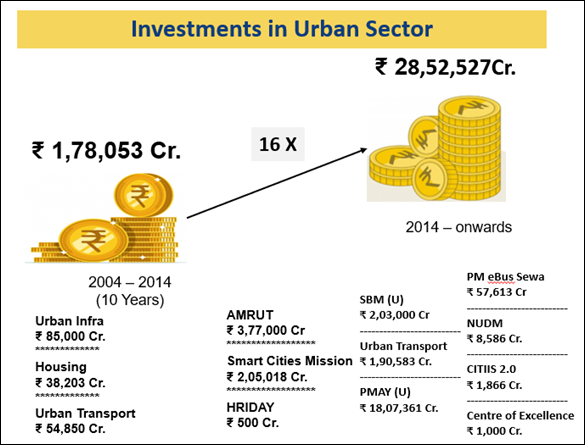
- The number of buses sanctioned from 2004-2014 were 14,405 and this increased to 19,752 during 2014-24.
AMRUT (Atal Mission for Rejuvenation and Urban Transformation)
Launched in 2015, AMRUT aims at ensuring every household has access to a tap with the assured supply of water and a sewerage connection, increasing the amenity value of cities by developing greenery and well-maintained open spaces (e.g. parks) and reducing pollution by switching to public transport or constructing facilities for non-motorized transport (e.g. walking and cycling). As of February 1, 2025, there are:
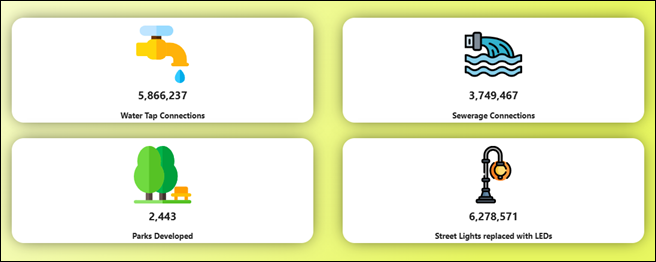
Jal Jeevan Mission
The Jal Jeevan Mission (JJM) was launched on August 15, 2019, with the ambitious goal of providing tap water supply to every rural household. At the time of its inception, only 3.23 crore (17%) of rural households had tap water connections. As of February 1, 2025, the Jal Jeevan Mission (JJM) has successfully provided tap water connections to 12.20 crore additional rural households, bringing the total coverage to over 15.44 crore households, which accounts for 79.74% of all rural households in India. This achievement marks a significant milestone in the mission.
